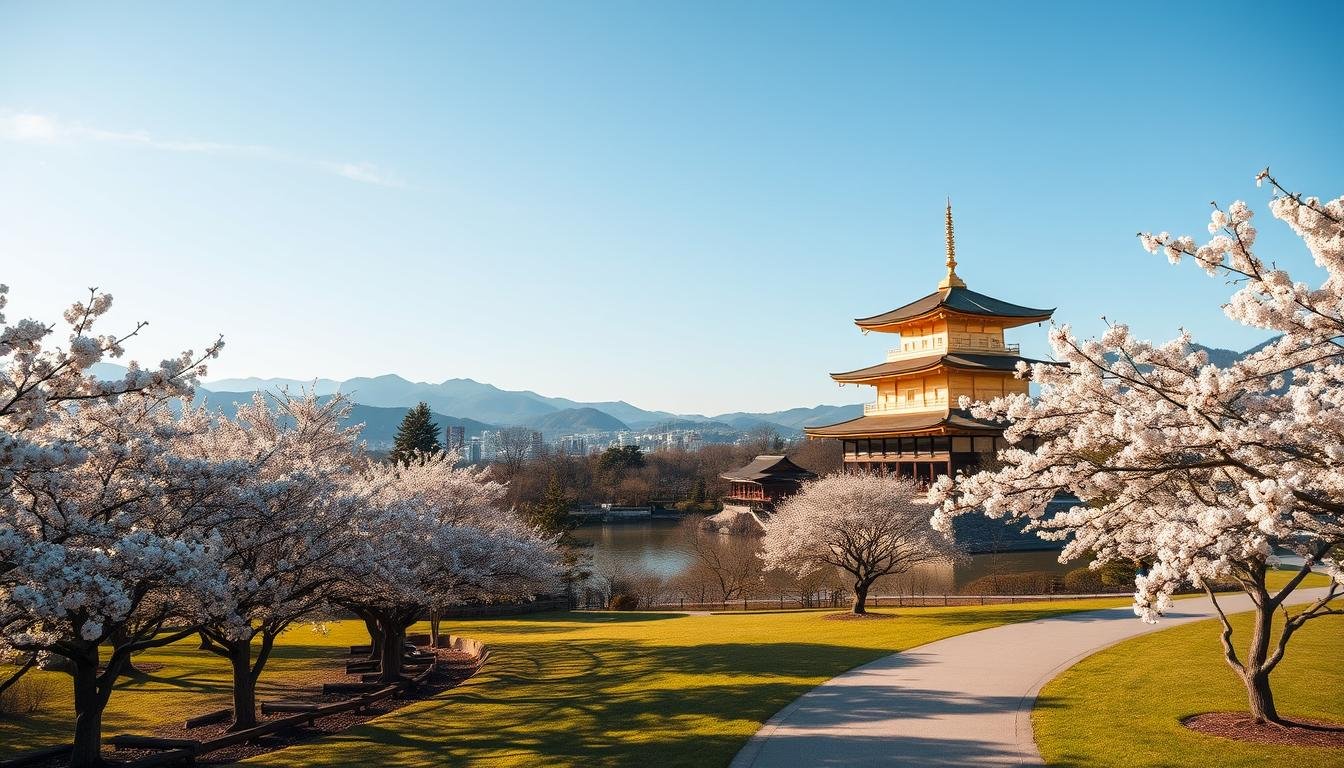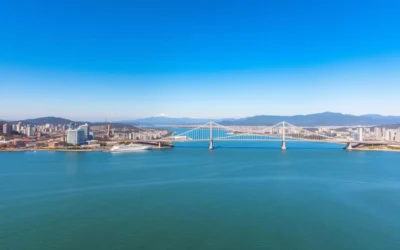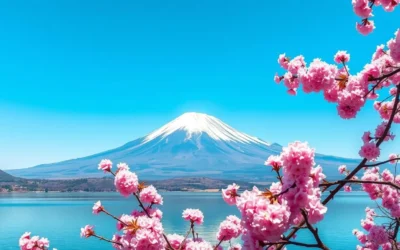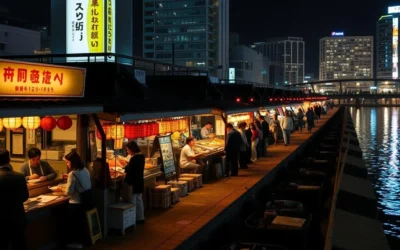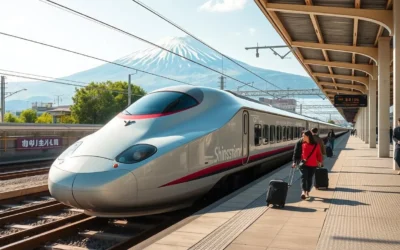✓ Accommodations✓ Flights✓ Rental Cars✓ Tours & Activities
Did you know that over 50 million people visit this historic destination every year? Its timeless charm and rich culture make it a must-see for travelers. If you’re planning a trip, a well-structured 7-day plan can help you experience the best it has to offer.
This itinerary is designed to balance historic sites, modern attractions, and cultural experiences. You’ll explore iconic landmarks, hidden gems, and local traditions. Whether it’s your first visit or a return trip, this plan ensures you make the most of your time.
From serene temples to bustling markets, every day is packed with unforgettable moments. Practical tips and real-life examples are included to make your journey smooth and enjoyable. Get ready to dive into a destination that blends the past and present like no other.
Introduction to Your 7-Day Japan Itinerary
Planning a week-long trip to Japan? Let’s make it unforgettable. This 7-day adventure is designed to give you a perfect mix of historical landmarks and modern marvels. Whether it’s your first visit or a return trip, this itinerary ensures you make the most of your time.
Over the course of a week, you’ll explore bustling cities, serene temples, and vibrant markets. Each day is carefully planned to balance sightseeing with relaxation. This way, you can immerse yourself in the culture without feeling rushed.
One of the keys to a successful trip japan is managing your time effectively. With so many attractions to see, it’s easy to feel overwhelmed. That’s why this plan includes practical tips to help you navigate transportation and language barriers with ease.
Here’s a quick overview of what to expect:
- A mix of historical sites and modern attractions.
- Tips on using public transportation efficiently.
- Advice on overcoming language challenges.
As you prepare for your journey, remember that a little planning goes a long way. “The best journeys are those that balance adventure with relaxation,” says a seasoned traveler. This itinerary is designed to do just that, ensuring you return home with unforgettable memories.
| Day | Focus | Key Activities |
|---|---|---|
| 1-2 | Tokyo | Explore modern landmarks and local markets. |
| 3-4 | Kyoto | Visit historic temples and cultural sites. |
| 5 | Nara | Discover ancient temples and interact with deer. |
By the end of your week, you’ll have experienced the best of Japan’s culture, history, and modernity. So, pack your bags and get ready for an adventure of a lifetime!
Planning Your Journey: Essential Japan Travel Tips
Traveling efficiently in Japan starts with smart planning. Understanding the transportation system and staying connected are crucial for a smooth experience. Here’s how to make the most of your trip with practical tips and tools.
Tips for Using the Japan Rail Pass
The Japan Rail Pass is a game-changer for exploring the country. It allows unlimited travel on most JR trains, including the famous Shinkansen. To activate your pass, exchange your voucher at designated JR offices, such as Narita Airport. Make sure to bring your passport and voucher for verification.
Plan your routes in advance to maximize the pass’s value. Use apps like Hyperdia or Google Maps to check train schedules. Remember, the pass is valid for consecutive days, so time your activation wisely. “The JR Pass saved me both time and money,” says a frequent traveler.
Reserving Pocket Wi-Fi and Financing Your Trip
Staying connected is essential for navigation and communication. Reserve a pocket Wi-Fi device online before your trip. Pick it up at the airport upon arrival, and return it before departure. This ensures you have reliable internet access throughout your journey.
Financing your trip doesn’t have to be stressful. Use credit cards widely accepted in Japan, and withdraw cash from ATMs at convenience stores. Many restaurants and shops also accept mobile payments like Apple Pay or Suica cards. With these tips, you’ll navigate Japan’s rail system and stay connected with ease.
Kyōto City, Japan: Itinerary Ideas for a 7-day Visit
Your journey to Japan deserves a well-thought-out plan to ensure every moment counts. From bustling cities to serene temples, this itinerary balances tradition and modernity. A key part of your trip is choosing the right accommodations. Staying in well-reviewed hotels or traditional ryokans can elevate your experience.
When planning your travel, consider the location of your hotel. Proximity to public transportation and major attractions saves time and energy. For instance, staying near Kyoto Station offers easy access to trains and buses. This convenience allows you to explore more without feeling rushed.

- Read reviews to ensure quality and comfort.
- Book early, especially during peak seasons like cherry blossom time.
- Consider ryokans for an authentic cultural experience.
Your trip structure is equally important. A well-planned itinerary ensures you don’t miss must-see spots. For example, allocate time for Kyoto’s historic temples and Tokyo’s modern landmarks. This balance keeps your journey exciting and fulfilling.
Remember, “The right hotel and itinerary can transform a good trip into an unforgettable one.” By focusing on these details, you’ll create memories that last a lifetime. Whether it’s your first visit or a return trip, this plan ensures you experience the best of Japan.
Day 1: Arrival in Tokyo and Initial Set-Up
Your adventure begins the moment you land at Narita Airport. As one of the largest international hubs, it’s designed to make your arrival smooth and stress-free. With five floors of shops, restaurants, and services, you’ll find everything you need to start your journey right.
First, head to the JR East Travel Service Center to exchange your JR Pass voucher. Located on the B1 floor, this is where you’ll activate your pass for unlimited train travel. Bring your passport and voucher for verification. “Exchanging the pass was quick and easy,” says a recent traveler.
Next, pick up your pocket Wi-Fi. Reserve it online before your flight and collect it at the airport. This ensures you stay connected for navigation and communication. With these essentials sorted, you’re ready to explore.
Navigating Narita Airport
Narita Airport is well-organized, but knowing your way around saves time. Here’s a quick guide:
- Arrivals are on the 1st floor, while departures are on the 3rd.
- Look for landmarks like post offices and security check areas to orient yourself.
- If you have a connecting flight, follow signs to the shuttle bus or train stations.
Managing your luggage is simple with coin lockers available on multiple floors. For those heading to Tokyo, the Narita Express train is your best bet. It connects directly to major stations like Tokyo Station, making it a convenient choice.
By the end of your first day, you’ll feel confident and ready to dive into the excitement ahead. With your JR Pass activated, Wi-Fi in hand, and a clear plan, your journey is off to a great start.
Traveling with Ease: Japan’s Bullet Trains and Rail System
Japan’s bullet trains are the backbone of efficient travel across the country. Known as Shinkansen, these high-speed trains connect major cities with unmatched speed and comfort. Whether you’re heading to bustling Tokyo or serene Kyoto, the rail system ensures you get there quickly and smoothly.
Understanding the different Shinkansen options can help you choose the best service for your needs. The Nozomi is the fastest, stopping only at major stations, while the Hikari and Kodama offer more stops, making them ideal for shorter journeys. Each option provides a comfortable ride, with spacious seats and onboard amenities.
Understanding Shinkansen Options
When planning your trip, consider the type of train that suits your schedule. The Nozomi is perfect for long-distance travel, reducing travel time significantly. For a more relaxed pace, the Hikari and Kodama allow you to enjoy the scenery while still reaching your destination efficiently.
Using a JR Pass simplifies your travel experience. This pass grants unlimited access to most JR trains, including Shinkansen, for a set period. To activate your pass, visit a JR ticket office with your passport and voucher. “The JR Pass made my journey stress-free and cost-effective,” shares a recent traveler.
- Compare Shinkansen options to match your itinerary.
- Activate your JR Pass at major stations for seamless travel.
- Book seats in advance to secure your preferred time and class.
Navigating Japan’s rail system is straightforward with a little preparation. Look for ticket counters at major stations, and don’t hesitate to ask staff for assistance. With these tips, you’ll travel with confidence and ease, making the most of your time in this incredible country.
Exploring Traditional Kyoto: Temples and Shrines
Immerse yourself in the spiritual heart of Japan with a journey through its most iconic temples and shrines. These sacred sites offer a glimpse into centuries of history, culture, and tradition. Whether you’re drawn to the vibrant red gates of Fushimi Inari or the golden serenity of Kinkaku-ji, each location tells a unique story.
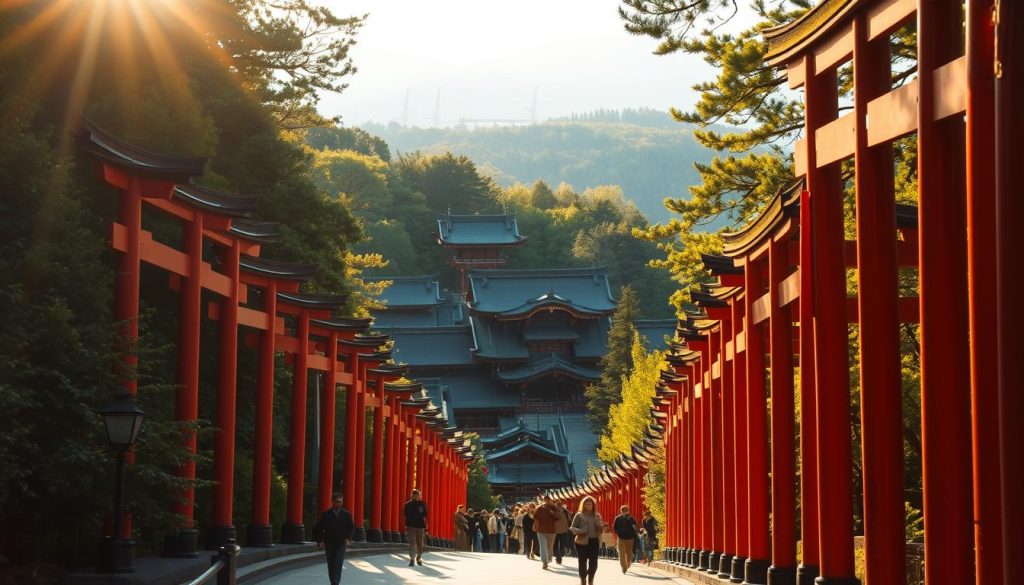
Highlights of Fushimi Inari-Taisha
Fushimi Inari-Taisha is famous for its thousands of red torii gates that form winding paths up Mount Inari. This shrine is dedicated to Inari, the Shinto god of rice and prosperity. Walking through the gates feels like stepping into another world, where nature and spirituality intertwine.
The hike to the summit takes about 2-3 hours, but even a short stroll offers breathtaking views. Early mornings or late afternoons are the best times to visit, as the crowds are thinner. “The serenity of the paths is unmatched,” says a frequent visitor.
Discovering Kinkaku-ji Temple
Kinkaku-ji, also known as the Golden Pavilion, is a Zen temple covered in gold leaf. Its reflection on the surrounding pond creates a picture-perfect scene. This UNESCO World Heritage Site is a must-see for its historical and architectural significance.
Entry to Kinkaku-ji costs 500 yen, and it’s open from 9 AM to 5 PM. To avoid the crowds, arrive early or visit during weekdays. The peaceful gardens and tranquil atmosphere make it a perfect spot for reflection.
| Site | Entry Fee | Best Time to Visit |
|---|---|---|
| Fushimi Inari-Taisha | Free | Early morning or late afternoon |
| Kinkaku-ji Temple | 500 yen | Early morning or weekdays |
Exploring these temples and shrines is more than just sightseeing—it’s a chance to connect with Japan’s spiritual heritage. Take your time, soak in the atmosphere, and let these timeless landmarks leave a lasting impression.
Experiencing Kyoto’s Cultural Treasures
Step into a world where tradition meets artistry in every corner. This destination is a haven for those seeking to immerse themselves in rich culture. From the elegance of geisha performances to the craftsmanship of local artisans, every moment is a celebration of heritage.
Strolling through historic districts offers a glimpse into the authentic pace of life. The narrow streets, lined with traditional wooden houses, invite you to slow down and appreciate the details. “Walking here feels like stepping back in time,” shares a recent visitor.
Geisha Performances and Traditional Arts
Witnessing a geisha performance is a highlight of any visit. These skilled entertainers captivate audiences with their graceful dances and musical talents. Book a private show or attend a public event to experience this iconic aspect of culture.
Local artisans also play a vital role in preserving traditions. Visit workshops to see craftsmen create pottery, textiles, and lacquerware. These hands-on experiences allow you to connect with the creative spirit of the place.
Unique Dining Experiences
No cultural journey is complete without savoring the local cuisine. Kyoto’s restaurants offer a blend of traditional and modern flavors. Try kaiseki, a multi-course meal that showcases seasonal ingredients, or visit a tea house for matcha and sweets.
For a more casual experience, explore street food stalls in bustling markets. From savory skewers to sweet treats, every bite tells a story. “The food here is as much about the experience as it is about the taste,” says a food enthusiast.
Exploring Art Galleries and Quaint Places
Art lovers will find plenty to admire in Kyoto’s galleries. From contemporary works to ancient masterpieces, the collections reflect the city’s artistic evolution. Many galleries are tucked away in quiet neighborhoods, making them perfect for a leisurely walking tour.
Don’t miss the chance to discover hidden gems like small temples, gardens, and boutique shops. These places offer a peaceful retreat from the bustling streets and a deeper connection to the local culture.
By the end of your visit, you’ll have experienced the rhythm of a city that cherishes its past while embracing the present. Whether it’s through art, food, or performance, Kyoto’s treasures leave a lasting impression.
Day Trip to Nara: Temples, Pagodas, and Deer Park
Discover the charm of Nara, where ancient temples meet friendly deer in a serene park. This day trip is a perfect blend of history and nature, offering something for everyone. From the towering pagodas of Kofukuji Temple to the playful wildlife of Nara Deer Park, every moment is unforgettable.
Visiting Kofukuji Temple
Start your journey at Kofukuji Temple, a UNESCO World Heritage Site. Its five-story pagoda, dating back to 730 AD, is a stunning example of Japanese architecture. The temple complex also includes the Eastern Golden Hall and the National Treasure Museum, where you can admire ancient artifacts.
Entry to the museum costs 700 yen, and it’s open from 9 AM to 5 PM. Arrive early to avoid crowds and take your time exploring the serene grounds. “The pagoda’s intricate design is breathtaking,” says a recent visitor.
Interacting with Wildlife at Nara Deer Park
Next, head to Nara Deer Park, home to over 1,000 friendly deer. These animals are considered sacred and roam freely throughout the park. You can feed them special crackers, called shika senbei, available for 200 yen at local vendors.
Remember to bow to the deer before feeding them—they might bow back! This playful interaction is a highlight of any day trip to Nara. “Feeding the deer was such a unique experience,” shares a traveler.
| Attraction | Entry Fee | Best Time to Visit |
|---|---|---|
| Kofukuji Temple | 700 yen (museum) | Early morning |
| Nara Deer Park | Free | Morning or late afternoon |
By the end of your day trip, you’ll have experienced the best of Nara’s history and nature. Whether it’s the awe-inspiring temples or the playful deer, this journey is sure to leave a lasting impression.
Adventure to Mt. Fuji: Scenic Nature and Local Vistas
Mt. Fuji’s majestic presence is a must-see for anyone visiting Japan. This iconic peak, standing at 3,776 meters, offers breathtaking views and a chance to connect with nature. Whether you’re an avid hiker or a casual traveler, the surrounding area is filled with unforgettable experiences.
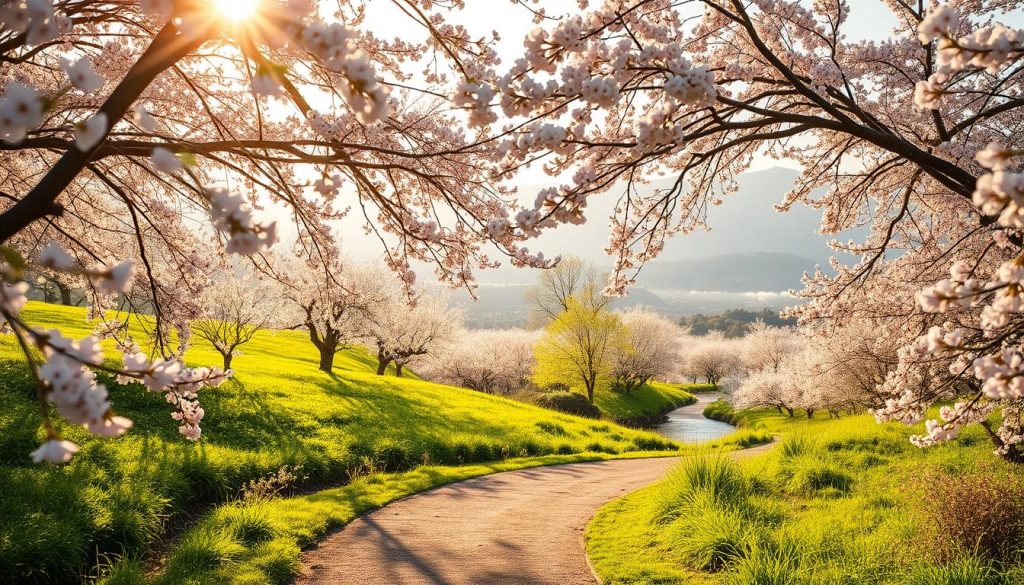
One of the best ways to enjoy Mt. Fuji is by visiting Lake Kawaguchiko. This serene lake provides stunning reflections of the mountain, especially during sunrise or sunset. The area is also famous for its seasonal beauty, with cherry blossom displays in spring and vibrant foliage in autumn.
Capturing Views at Lake Kawaguchiko
To reach Lake Kawaguchiko, take a direct bus from Tokyo’s Shinjuku Station. The journey takes about two hours, making it an ideal day trip. Once there, explore the lakeside by foot or rent a bike for a more immersive experience. The forest trails around the lake offer peaceful walks and photo opportunities.
During spring, the cherry blossom season transforms the area into a pink paradise. The blossoms frame the mountain, creating a picture-perfect view. “Seeing Mt. Fuji surrounded by cherry blossoms was like a dream,” shares a recent visitor.
For the best views of Mt. Fuji, head to the northern shore of the lake. Local buses run frequently, making it easy to access key spots. Don’t forget to check the weather forecast, as clear skies are essential for a perfect view of the mountain.
Exploring Tokyo’s Modern Landmarks
Tokyo’s skyline is a blend of tradition and innovation, offering endless exploration opportunities. From towering skyscrapers to bustling shopping districts, the city’s modern landmarks are a testament to its dynamic spirit. Whether you’re soaking in panoramic views from an observation deck or strolling through vibrant streets, Tokyo’s urban landscape is sure to captivate you.
Experiencing Tokyo Tower and Skytree
Tokyo Tower and Tokyo Skytree are two iconic structures that define the city’s skyline. Tokyo Tower, standing at 333 meters, offers a classic observation deck with stunning views of the metropolis. For a more futuristic experience, head to Tokyo Skytree, which soars to 634 meters, making it the tallest tower in Japan. Its Tembo Galleria provides a 360-degree view that’s perfect for photography enthusiasts.
To avoid crowds, visit early in the morning or late in the evening. Both landmarks also feature shops and cafes, allowing you to relax and enjoy the scenery. “The view from Skytree at sunset is absolutely magical,” says a recent visitor.
Exploring Vibrant Shopping Streets
Tokyo’s streets are a shopper’s paradise, offering everything from high-end boutiques to quirky local shops. Takeshita Street in Harajuku is famous for its trendy fashion and unique souvenirs. For a more upscale experience, visit Ginza, where luxury brands and department stores line the streets.
Don’t miss Nakamise-dori, a historic shopping street near Senso-ji Temple. With over 90 shops, it’s the perfect place to pick up traditional crafts and snacks. “The energy of these streets is infectious,” shares a traveler.
| Landmark | Height | Best Time to Visit |
|---|---|---|
| Tokyo Tower | 333 meters | Early morning or late evening |
| Tokyo Skytree | 634 meters | Sunset or early morning |
By the end of your day, you’ll have experienced the best of Tokyo’s modern landmarks. Whether it’s the breathtaking views from an observation deck or the lively atmosphere of its streets, the city’s energy is unforgettable.
Navigating Public Transportation in Japan
Getting around Japan’s cities is easier than you might think, thanks to its world-class public transportation. Whether you’re exploring bustling Tokyo or quieter areas, the system is designed to get you where you need to go efficiently. With a little preparation, you’ll feel like a local in no time.
Using IC Cards and Subways Efficiently
IC cards, like Suica or Pasmo, are your best friends for seamless travel. These rechargeable cards work on trains, subways, buses, and even at convenience stores. Simply tap your card at the gate, and you’re on your way. No need to fumble for change or buy individual tickets.
To get started, purchase an IC card at any major station. Load it with credit, and you’re ready to go. “Using an IC card made my travels so much smoother,” says a recent visitor. It’s a small investment that saves time and hassle.
Mastering the Subway System
Japan’s subway systems are extensive but easy to navigate with a few tips. Start by downloading apps like Google Maps or Hyperdia for real-time schedules and routes. These tools show you which train to take, the best car to board, and even the closest station exit to your destination.
Here’s how to make the most of your subway experience:
- Arrive at the platform 10-15 minutes before departure to avoid rushing.
- Look for priority seating and designated areas for luggage.
- Use station maps to plan transfers and exits efficiently.
Whether you’re heading home or exploring a new part of the country, Japan’s public transportation ensures a stress-free journey. With these tips, you’ll travel confidently and make the most of your time.
Where to Stay: Hotels, Ryokans, and Accommodations
Finding the right place to stay can make or break your travel experience. Whether you’re drawn to modern hotels or traditional ryokans, choosing the perfect area ensures convenience and comfort. This guide will help you navigate the diverse lodging options available in Kyoto and Tokyo.
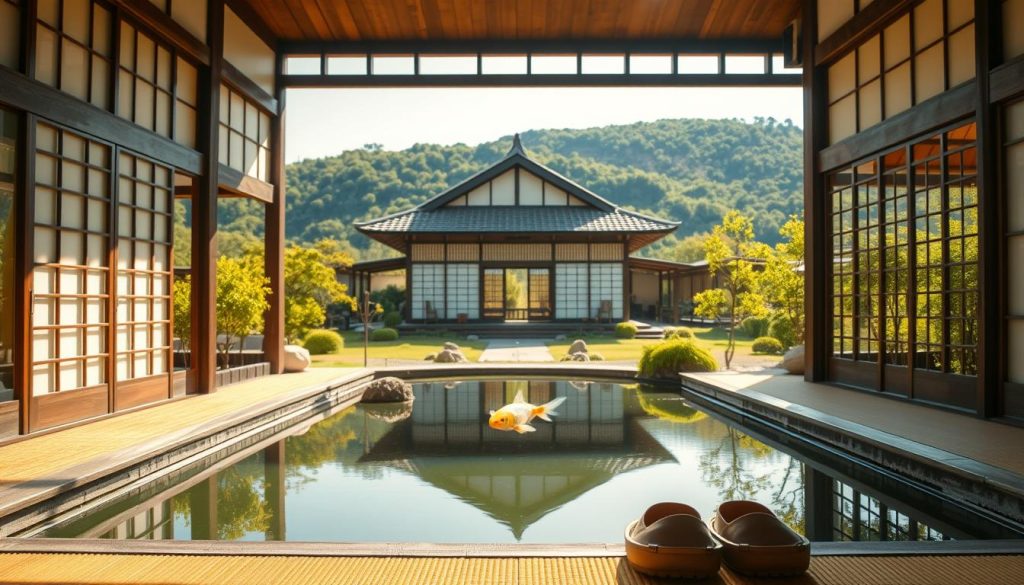
In Kyoto, staying near the cherry-lined streets of Higashiyama offers easy access to historic temples and serene gardens. For those prioritizing convenience, accommodations near Kyoto Station provide seamless connections to other parts of the area. “Staying near the station saved me a ton of time,” shares a recent visitor.
Tokyo, on the other hand, boasts a mix of luxury hotels and budget-friendly options. Staying in Shinjuku or Shibuya places you in the heart of the action, with vibrant nightlife and shopping just steps away. For a quieter experience, consider the upscale area of Ginza.
Modern Hotels vs. Traditional Ryokans
Modern hotels in both cities offer amenities like Wi-Fi, fitness centers, and on-site dining. They’re ideal for travelers seeking comfort and convenience. In contrast, ryokans provide a unique cultural experience with tatami-matted rooms and communal baths. “Staying in a ryokan was a highlight of my trip,” says a satisfied visitor.
Here’s a quick comparison to help you decide:
| Accommodation Type | Best For | Key Features |
|---|---|---|
| Modern Hotels | Convenience and amenities | Wi-Fi, fitness centers, on-site dining |
| Ryokans | Cultural immersion | Tatami rooms, communal baths, traditional meals |
For those traveling in groups or seeking more space, Airbnb rentals are a great alternative. They often provide larger accommodations without extra per-person charges. Staying in a machiya, a traditional wooden townhouse, is another unique option in Kyoto.
No matter where you stay, choosing the right area is key. Whether it’s the bustling streets of Tokyo or the serene temples of Kyoto, your accommodations should enhance your overall experience. With these tips, you’re sure to find the perfect place to rest and recharge during your journey.
Balancing Historic Charm with Modern Excitement
Discover the perfect blend of old and new in this captivating destination. From ancient temples to cutting-edge technology, the contrast between tradition and innovation is what makes this place so special. By balancing these elements, you’ll create a travel experience that’s both enriching and unforgettable.
Start your day with a visit to a historic site, like a centuries-old shrine or temple. These landmarks offer a glimpse into the history and culture that shaped this region. Take your time to explore the intricate details and serene surroundings. “Walking through these sites feels like stepping back in time,” says a recent visitor.
After immersing yourself in the past, shift gears and dive into the modern side of the city. Visit a bustling shopping district or a futuristic observation deck. These attractions showcase the vibrant energy and innovation that define the present. The contrast between the two worlds is striking yet harmonious.
Here’s how to plan a day that balances both worlds:
- Morning: Explore a historic neighborhood or temple.
- Afternoon: Visit a modern museum or shopping area.
- Evening: Enjoy a meal that blends traditional and contemporary flavors.
This approach ensures you experience the best of both worlds without feeling rushed. A friendly note: Take breaks between activities to fully appreciate each experience. This way, you’ll return home with a deeper understanding of the destination’s unique character.
| Type of Experience | Historic Attractions | Modern Attractions |
|---|---|---|
| Morning | Visit ancient temples or shrines. | Explore modern art galleries. |
| Afternoon | Walk through historic districts. | Shop in bustling urban centers. |
| Evening | Attend a traditional performance. | Dine at a contemporary restaurant. |
By the end of your trip, you’ll have a well-rounded appreciation for the destination’s history and its modern achievements. Embrace both worlds, and you’ll leave with memories that span centuries.
Insider Tips for Maximizing Your 7-Day Journey
Make the most of your trip with these insider tips for a seamless and enriching experience. Whether you’re exploring bustling markets or serene temples, these suggestions will help you get the most out of each day.
Local Dining and Shopping Recommendations
For authentic flavors, try local restaurants that serve traditional dishes like sushi, ramen, and kaiseki. Street food stalls in markets are also a great way to sample quick, delicious bites. “The food here is as much about the experience as it is about the taste,” says a food enthusiast.
When shopping, visit districts like Harajuku for trendy fashion or Nakamise-dori for traditional crafts. These areas offer unique souvenirs and a chance to immerse yourself in the local culture.
Observations on Cultural Etiquette
Respecting local customs is key to a positive experience. Always bow when greeting someone, and remove your shoes before entering homes or certain restaurants. When visiting temples, maintain a quiet demeanor and avoid touching sacred objects.
Here are a few more tips to keep in mind:
- Carry cash, as many smaller establishments don’t accept credit cards.
- Use both hands when giving or receiving items, as it’s considered polite.
- Dispose of trash properly, as public bins are rare.
By following these guidelines, you’ll show respect for the culture and leave a positive impression as a tourist.
Conclusion
Your journey through this incredible destination is about to become a cherished memory. Every thing you’ve experienced—from historic temples to modern marvels—has added up to an unforgettable adventure. The practical tips and cultural insights shared in this guide are designed to make your trip seamless and enriching.
As you finalize your plans, take a moment to review the guide again. Each thing—whether it’s a travel tip or a hidden gem—plays a role in creating an extraordinary experience. From efficient transportation to unique dining, every detail matters.
With a lot of inspiration and confidence, you’re ready to embark on this adventure. Embrace the blend of tradition and innovation, and let the memories you create last a lifetime. Your journey is just beginning—make it unforgettable.
The above is subject to change.
Check back often to TRAVEL.COM for the latest travel tips and deals.
